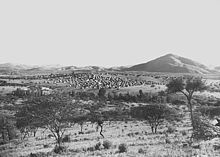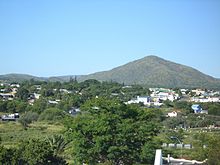- Old Location
-
The Old Location (or as it was known then the Main Location) was an area segregated for Black residents of Windhoek, the capital of Namibia. It was situated in the area of today's suburb Hochland Park.
Upon the creation of the neighborhood in 1912 by the Windhoek City Council, all Black residents of other areas of the city were moved to the Main Location. A year later, streets were laid out and the separation of Black ethnic groups took place, with each ethnic group forced to live in a different section. Administration of the area was split between Black local residents and White residents from elsewhere.
Old Location Uprising
During the 1950s, the Windhoek municipality and the South African colonial administration decided to forcefully move the residents of the Main Location 8 km to the north of the city, prompting the evicted people to give the new location the name Katutura (Otjiherero "The place where we do not want to live").[1] Most residents did not want to move and protests came to a head in December 1959. Following protests and an effective boycott of municipal services by Main Location residents, the police opened fire on the protesters, killing 11 and wounding 44 others. Doctors at the hospitals in Windhoek refused to treat the wounded, telling them to "go to the United Nations for treatment because these people ... [are] political patients".[2] Although this claim is backed by many eyewitnesses, among them Sam Nujoma, Namibia's founding president who references the incident in his autobiography Where Others Wavered, it has not been unchallenged. Hannes Smith caused a controversy in 2003, calling it a "gross lie".[3]
3000-4000 residents fled the area and refused to return, fearing police reprisals. The Old Location Uprising, as it came to be known, was a rallying cry for Namibian independence until the country received independence in March 1990, 31 years later.[4][5] It was one of the events leading to the foundation of SWAPO[6] by forcing community leaders from the Ovamboland People's Organization into exile, including Sam Nujoma.[1] The Old Location uprising is the reason for the declaration of December 10, Human Rights Day, as a Namibian national holiday.
In 1968, the Old Location was officially closed and whites began to settle.
References
- ^ a b Klaus Dierks. "History of Namibia". http://www.klausdierks.com/Chronology/101.htm. Retrieved 2009-11-03.
- ^ Dierks, Klaus. "BIOGRAPHIES OF NAMIBIAN PERSONALITIES (Entry for Schimming-Chase, Nora)". http://www.klausdierks.com/Biographies/Biographies_3.htm. Retrieved 7 May 2010.
- ^ Nujoma's war of words with editor in the Mail & Guardian, 30 August 2003
- ^ History of Old Location and Katutura NamibWeb.com
- ^ Forced Removal from Old Location Vantaa.fi
- ^ Peter N. Stearns and William Leonard Langer. The Encyclopedia of World History: Ancient, Medieval, and Modern, Chronologically Arranged, 2001. Page 1070.
Categories:- History of Windhoek
- Shanty towns
- Places associated with apartheid
Wikimedia Foundation. 2010.


